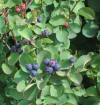WILD
FOODIES' HOME PAGE
PLANT PROFILE LIST
NAME: Juneberry (many species)
SPECIES / FAMILY: Amelanchier Canadensis / Rosaceae
OTHER COMMON NAME(S): Serviceberry, Shadbush, Sugarplum
CONDITIONS:
partial shade
|
PARTS: |
EDIBLE |
TASTE |
RAW/COOK |
SEASON |
|
All |
|
|
|
|
|
Shoots |
|
|
|
|
|
Leaves |
||||
|
Stalk/Stem |
|
|
|
|
|
Buds |
||||
|
Flowers |
|
|
|
|
|
Fruits |
|
sweet |
RAW/DRY/COOK |
Jun |
|
Pods |
|
|||
|
Seeds |
|
|
|
|
|
Nuts |
|
|
|
|
|
Roots |
|
|
|
|
|
Bark |
|
|
|
|
PORTION: small-medium
COMMENT: Juneberries taste best just freshly picked. After that you might want to combine them with other berries that have pectin, such as hawthorns that you've saved from last fall, and then maybe add some honey. Or make wine with them, or cook them into a pie, pancakes, etc.. // Small tree/bush with blue or red berries. Edible fruit - raw or cooked. The fruit contains a few small seeds at the centre, it has a sweet flavour with a hint of apple. It can be eaten out of hand, used in pies, preserves etc or dried and used like raisins. We have found the fruit to be of variable quality, with some forms having a distinct bitterness in the flavour whilst others are sweet, juicy and delicious. When the fruit is thoroughly cooked in puddings or pies the seed imparts an almond flavour to the food. (1) Juneberries were one of the famous traditional ingredients in pemmican, which was fat and powdered meat, or, fat, powdered meat and dried berries.(2) http://www.practicalprimitive.com/skillofthemonth/pemmican.html
CAUTION: Juneberries are susceptible to Cedar-Apple Rust disease - https://en.wikipedia.org/wiki/Gymnosporangium_juniperi-virginianae The recommended method of control is to “remove cedars located within a 1-mile radius” of the apples to interrupt the disease cycle,though this method is seldom practical.(3) (Please, do not use toxic fungicides to control disease.)
NUTRITION/MEDICINAL: The fruit is rich in iron and copper. Anthelmintic; Disinfectant; Women's complaints. A tea made from the root bark (mixed with other unspecified herbs) was used as a tonic in the treatment of excessive menstrual bleeding and also to treat diarrhoea. A bath of the bark tea was used on children with worms. An infusion of the root was used to prevent miscarriage after an injury. A compound concoction of the inner bark was used as a disinfectant wash.(1)
LOOK-A-LIKES:
POISONOUS LOOK-A-LIKES:
OTHER USES: Disinfectant; Hedge; Hedge; Rootstock; Shelterbelt; Wood. This species can be used as a dwarfing rootstock for Malus spp. (the apples) and Pyrus spp. (the pears). Plants can be grown as an informal hedge. Any trimming is best done after flowering. A fairly wind-tolerant species, it can be used to give protection from the wind as part of a mixed shelterbelt. Wood - hard, strong, close grained. Used for tool handles, small implements etc.(1)
SOURCE LINKS (may include nutritional and medicinal info, plus other uses):
- https://pfaf.org/user/plant.aspx?LatinName=Amelanchier+canadensis
- http://www.eattheweeds.com/amelanchier-arborea-busting-out-all-over-2
-
https://en.wikipedia.org/wiki/Amelanchier
https://en.wikipedia.org/wiki/Amelanchier_canadensis - https://www.thespruce.com/nine-species-serviceberry-trees-and-shrubs-3269674 (good photos)
- https://extension.umn.edu/trees-and-shrubs/serviceberry
- Philly's POP https://www.phillyorchards.org/2016/06/04/plant-spotlight-the-joyful-juneberry-amelanchier-species (recipe)
- https://www.motherearthnews.com/real-food/foraging-for-juneberries-and-juneberry-pie-recipe-zbcz1506 (recipe)
- http://foragedfoodie.blogspot.com/2012/06/identifying-juneberries-serviceberries.html (recipe)
- https://chicagomushroomman.wordpress.com/2014/06/29/juneberry-wine-making (recipe)
- https://www.backyardforager.com/serviceberry-pudding (recipe)
-
https://www.youtube.com/watch?v=rz04QXMM33A
Simple Sweet Juneberry Jam Recipe




